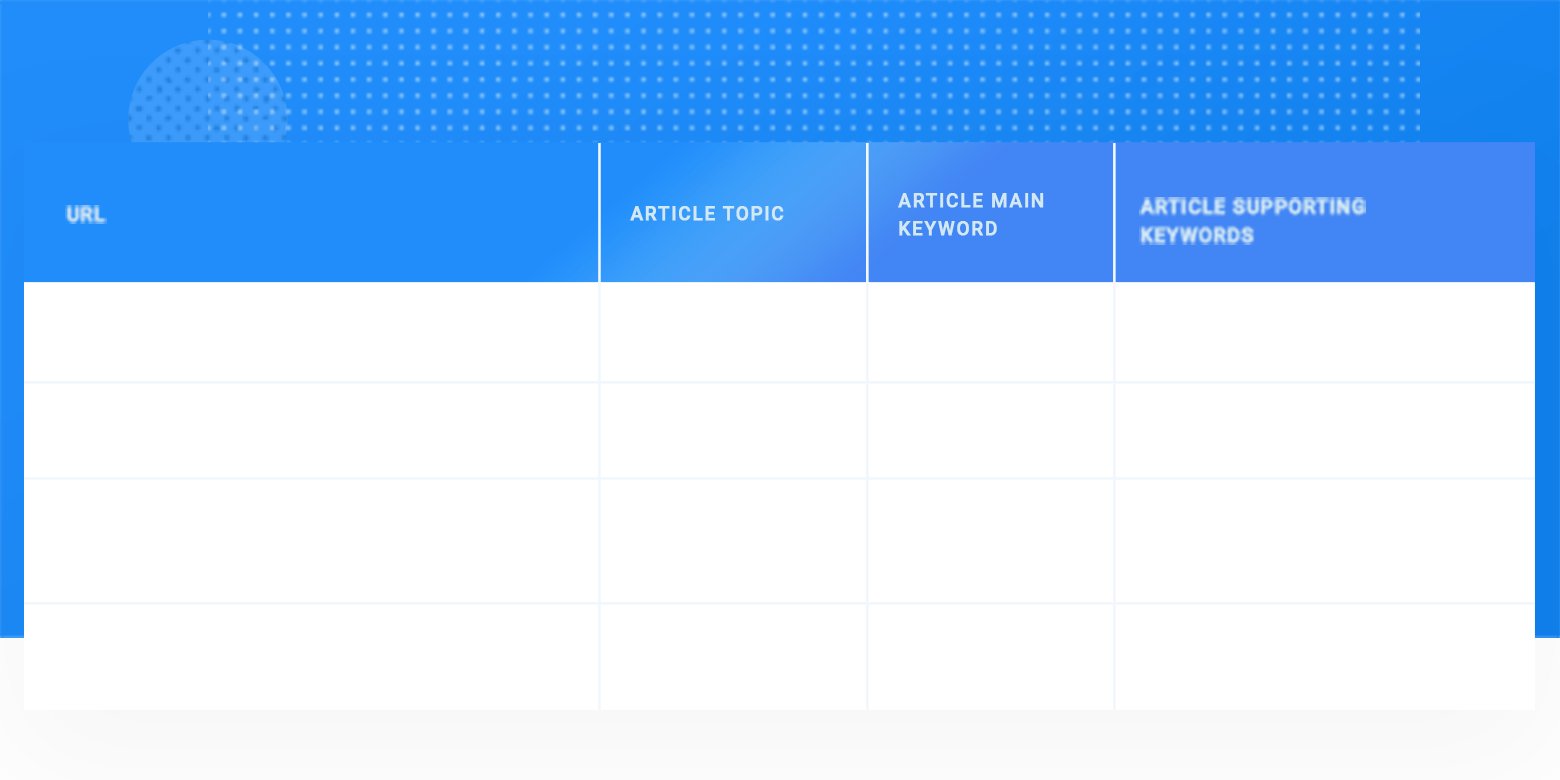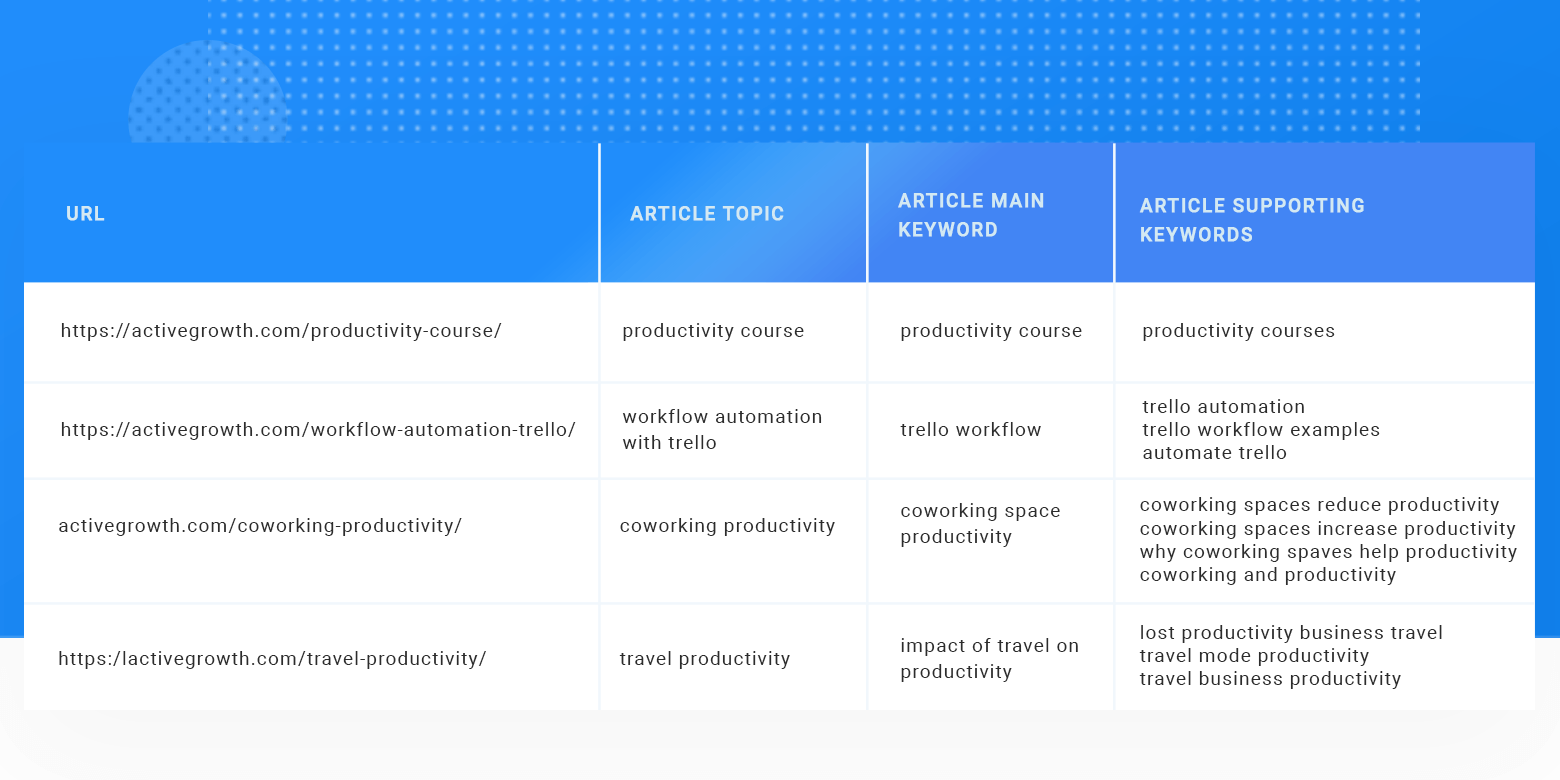In this article, you will learn how to give your target keywords a home on your website.
You’ll learn which pages should be optimized for SEO — and which ones should be used for other purposes.
The process I’m going to teach you in this post is called keyword mapping. It’s the missing link between effective keyword research (finding great search term opportunities) and establishing a traffic boosting content plan.
When you start studying SEO (search engine optimization: the process of ranking your website on Google), you will quickly learn about keywords, keyword research and content optimization.
Let’s briefly recap what those key SEO elements are to be on the same page with our terms and knowledge…
Users have a specific need when searching on Google. This “why” is the topic they are researching, the thing they want to learn about, the appointment they are looking to book, the product they want to buy.
Their reason for searching is called search intent. And your page about a specific topic is meant to meet that search intent and satisfy a Google Search user’s needs.
If your content is the best answer to a given search query, you will appear on page 1 of Google. This is your goal if you want to grow qualified organic traffic.
Google is a text-based algorithm, so we use keywords to model the topics and search intent of the user. Keywords are the “what” we can see: They are the search query someone types into Google.
But this is where things get tricky. How do you actually turn a list of target keywords into a content plan? Where should these SEO focused articles even live on your website?
Keep reading to find out how to turn your abstract keyword list into an actionable content creation game plan to boost your website’s organic traffic.
In fact, no SEO teacher ever seems to talk about your product, services pages, the about page, podcast or lead magnet pages and leave you hanging as to what keywords these pages should be optimized for…
This struggle is a recurring theme for students of our online training course “SEO sprint for the busy solopreneur” — and we wanted to shed some light on it with this post. So, let’s dive in and turn your abstract keyword list into an actionable content creation game plan to boost your website’s organic traffic.
This article was originally published on Thrive Themes.
Table of Contents
What Is Keyword Mapping?
Keyword mapping is the process of assigning your target keywords to specific pages and blog posts on your website. It tells you what keywords to use for every single page/post and thus guides your content creation process.
It turns a long list of hundreds of keywords into a website structure and content plan.
Essentially, a keyword map is just a spreadsheet that includes all your pages on the website in one column and the assigned target topics in another column.
The goal is for every topic and target keyword to have one designated piece of content aiming to rank high for a main keyword as well as supporting search terms.
Your keyword map framework could look as simple as this:

A template for keyword mapping.
If we take a look at Shane’s entrepreneurship blog ActiveGrowth as an example, the following keyword map shows every article that discusses the parent topic of productivity, but each one aims to satisfy a different search intent:

An example of keyword mapping around the parent topic of “productivity” created for Shane’s ActiveGrowth entrepreneurship blog.
Why Keyword Mapping Matters
The good news: When we talk about content creation for SEO, we’re always talking about evergreen content.
This means you can take your time to create good, in-depth resources instead of forcing yourself to pump out eight crappy blog posts every week.
This is where keyword mapping comes into play: Each topic you want to rank for needs one specific home on your website. If you want to rank better or discuss the topic again, you should just update your existing page for it.
Keyword mapping allows you to avoid keyword cannibalization (several pages on your own site fighting for the same keyword) and content duplication (writing about the same topic over and over again).
Common Page Types And Target Keywords
Let’s look at some pages that virtually every website has and whether or not they are relevant for SEO. And if they are relevant, we’ll look at what type of keywords they should be optimized for.
Just keep in mind that pages and blog posts are the same in Google’s eyes (the one caveat to this rule is that blog articles have publish dates which you’ll need to update every now and then).
Typically, pages are used to create landing pages like About or About the Team pages, Our/My Services pages, etc. Blog posts are usually used to publish your educational content.
And whilst that is the most common structure, you can also organize your content differently and still keep the search engines happy. What matters for SEO is keyword mapping and content optimization, not whether you decide to publish a piece of content as a post or page in WordPress.
With that said, let’s look at some of the most common site pages and how you can optimize them for more search engine love.
Homepage
Your homepage will always be one of the most powerful SEO pages on your website because it receives the most links through brand mentions. It is also the entry point for those people searching for your brand on Google.
The purpose of the homepage is to help people understand your business and what you offer. It should display your products, services and content, as well as guide users deeper into the website.
You want to optimize your website for:
- Your brand name first and foremost, and…
- The one overarching theme that describes the purpose of your business.
For “overarching-theme” optimization, that could be “bookkeeping services London”, “time tracking”, etc.
Website Core Pages: About, Team, Contact, Terms of Service
These pages are not meant for SEO. Instead, they are primarily for conveying trust and authority. Some of them are even legal requirements.
Keep these pages indexed and part of your navigation, but they do not require a specific target keyword assigned to them.
If anything, you want these pages to appear for “brand + team” or “brand + contact” if someone searches for them on Google.
Product And Services: Sales Pages
These pages are where the money is. They are sales pages for your services, products, courses, etc.
In most cases, you want them to rank for very transactional, bottom-of-the-funnel keywords like “bookkeeping services Lisbon”, “project management software” or “fitness online course for pregnant women”.
However, these pages come with a few SEO caveats:
- Transactional keywords tend to convert well and deliver very qualified traffic (hence, they are very competitive and the pages that rank high for them almost always require backlinks).
But people do not like linking to sales pages (unless they are affiliates and receive a commission for the referral).
So in order to collect backlinks, you’ll likely need to create educational content that provides more context and information to your visitors. For example, if you want to try to rank your service/sales page for “SEO agency Berlin”, you need to create educational content for “how to choose an SEO agency” or “goal setting for SEO” which become your backlink targets.
To then make your service/sales page rank, you need to internally link from the backlinks educational content to the service/sales page. Uff… that’s some next level SEO skills right there! - Google might not like ranking a sales page for a given search query. If this is the case, then you can write and optimize your sales page perfectly, but it still won’t rise to page 1.
So when you review the results that are on page 1 for a given search term, pay close attention to the types of content being displayed. Are they primarily comparison or review posts highlighting several products/services without a single sales page among them?
If so, you’ll just keep banging your head against the wall trying to get your own sales page ranked. Instead of optimizing your sales page, you might find more success writing an in-depth educational guide on “things to consider when picking a project management software” or “the best fitness routine for pregnant women, incl. apps and online courses” to rank at all.
In the end, let what Google “wants” guide you by observing its current top search results.
If you do not find any sales pages on page 1 of Google for your target keywords, optimize your sales/product pages for your brand + product name (e.g. “Thrive Architect” or “Thrive Theme Builder”) instead and then create educational content targeting something like “how to pick a WordPress theme builder” for your blog in order to win that keyword.
Generally speaking, your service and product pages will be part of your navigation, and the main purpose of the page is to generate sales or bookings.
Example: Digital Products And Courses
Shane wants the sales page for his ActiveGrowth “focus and action” course to rank for “productivity course”. You can just look at the URL of his sales page to see that he’s optimizing for it: https://activegrowth.com/productivity-course
Shane’s “focus and action” productivity course was optimized for the target keyword “productivity course”.
Example: Local Services
If you are a local business, you want your services page to be optimized for the service you offer AND your city. For example:
- Dentist Denver
- Digital marketing freelancer Boulder Colorado
- Wedding planner East Village New York
Don’t try to rank your service page for “dentist” or an equally general keyword like “digital marketing freelancer” because they’ll just be insanely hard to win.
And if your particular city is too competitive, consider building out additional pages that go even more granular targeting “service + neighborhood + city”. For example:
- Dentist Capitol Hill Denver
- Dentist Five Points Denver
Real Content Pages And Posts
These are your prime SEO targets!
Real content pages include blog posts, articles, guides, and the other page types not mentioned yet. When we talk about SEO content, these types of posts and pages are almost always what’s being referred to.
The ActiveGrowth Webinar Ninja Review blog post is just one example of a real content page (in this case a real content post).
The vast majority of your target keywords will be mapped against these pages.
Again, you can use either pages or blog posts for this — they both work.
What matters is that you assign one specific topic to each page/post, write an in-depth and highly engaging article, and optimize it for a given set of keywords. (Detailed process on how to do that below.)
These pages will also be the most common entry points for organic traffic.
Here are a few examples:
- https://activegrowth.com/webinar-ninja-review for “webinar ninja review”
- https://activegrowth.com/adobe-alternatives for “adobe alternatives”
- https://activegrowth.com/workflow-automation-trello for “trello automation”
If you click through to look at the articles, you’ll see that each one covers a given topic in-depth while also using keywords in a strategic way. These articles are long and full of both synonyms and variations of the main target keyword.
This is exactly what Google likes to see!
Again, reviewing page 1 for a given search term will be very helpful for you to understand the depth to which you should cover a certain topic. If everyone is writing a 2,000-word guide on the topic — so should you.
This is the content foundation that SEO nerds always talk about.
The general idea is to cluster topics into buckets. So, if your services are “bookkeeping services London” and “tax advisor London”, you might want to try and rank for these search terms by writing about bookkeeping and tax topics on your blog.
Topics and keywords to create strategic blog content around to help rank for such keywords could include:
- Choosing the best bookkeeping tool
- Setting up invoices in Xero
- Automating your monthly bookkeeping
- How to read a profit and loss statement
- Tax deadlines in England
- Etc.
Let’s now talk about how you should organize all these SEO articles.
Categories, Tags, Parent Pages, Silo Pages, Hubs/Pillar Pages
When it comes to SEO, I am big fan of structure and thinking in terms of topic buckets.
But the thing is that an out-of-the-box WordPress website usually gets people publishing content without any thought given to structure whatsoever. In fact, your standard WordPress blog just lists all its published posts on an archive page sorted by date.
Of course you should keep that blog archive page… it just doesn’t need to be optimized for a specific keyword since it’s just an archive page showing a list of articles: https://activegrowth.com/blog
A WordPress blog page is just an archive page that lists all your site’s blog posts in chronological order. By all means keep it, but there’s no need to optimize it for any target keywords.
But if you actually want to structure and organize your content for SEO, I want you to think of your website more like a library of resources. Make it easy for both Google and human visitors to find what they are looking for quickly.
Thinking in topic buckets means that you need to cluster your SEO articles and make sure that related topics live in the same neighborhood of your website.
Rock Solid Site Structure
Some people call this a “silo structure” while others call it “hub pages” or “pillar pages”. Whatever you call it, the words all express the same concept: Creating a “mini homepage” for a content theme and listing all relevant articles on that page.
If a visitor wants to learn about making great webinars, they should be able to find all information related to that topic in one place.
Shane did this on his own ActiveGrowth website, where he structured years of content into the following silos:

The ActiveGrowth site header displays all of the different silo page links (a.k.a. main site topics) in one place.
- Entrepreneurial Skills
- Incl. entrepreneurial mindsets
- Productivity
- Incl. productivity tools
- Building an Audience
- Incl. growing site traffic
- Create & Launch a Product
- Incl. product idea validation
- Marketing Tools & Tutorials
- Incl. webinars
You can establish this structure on your website by using your existing blog categories. (Here’s a good explanation of why I am not a big fan of using tags for this.)
Aim for creating silo pages only for a handful of clearly distinct blog categories and make sure that each post on your blog is assigned to one silo category only.
This also means you can turn your standard category archives into appealing hub/silo pages instead.:

In fact, Thrive Theme Builder allows you to create fantastic looking blog category silo pages with speed and ease!
Want To Rank Your Silo Pages?
The one-million-dollar question is: Are your silo/hub pages meant for ranking?
Well, first and foremost, they are meant to provide clarity and structure for consumers of your content and thereby support your real content pages to rank well.
So, the depressing SEO answer on whether or not to optimize keywords for your silo/hub pages is — it depends!
If your service page target keyword is “digital marketing freelancer Boulder,” you might build a silo called “digital marketing” with a really good looking resource library.
But even though that’s a well-structured website that makes sense to visitors, you probably won’t rank for that keyword because it is so insanely competitive.
So, the approach for mapping keywords against silos/hubs/categories is this: Use silo/hub pages mainly as a tool for structure.
If you can find a relatively high volume, low-difficulty keyword to optimize these pages for — go for it! But do not compromise your site structure on the hope of ranking a single keyword. For the most part, silo/hub page target keywords will be too broad and thus too competitive for you to win.
WordPress Permalinks and SEO
Here’s a final word of caution on URLs: Website structure and topic clusters are about more than just your permalinks.
WordPress permalinks can be a tricky beast. That’s because the click of a button on your backend can change ALL your old URLs and end up negatively impacting your SEO tremendously if you do not correctly assign redirects from the old URLs to the new URLs to manage such structural modifications.
Most solopreneurs will therefore want to stick with the URL structure they have if already ranking well for some of their target keywords.
Today, most people set their permalinks to “postname” and then manually edit them to something short and well-optimized: domain.com/keyword/.
In the SEO Sprint for Busy Solopreneurs course, Shane and I taught about how to set up domain.com/silo/keyword/ to increase clarity, but it led to a lot of confusion for students with existing websites. In most cases, I would recommend sticking with the standard “postname” permalink structure you already have if you’re in this boat.
Paid Ad Landing Pages, Lead Gen Landing Pages, etc.
In most cases, you will be running paid traffic (Google Ads, Facebook Ads, etc.) almost exclusively to these pages or only link to them within your email campaigns and automations.
Such landing pages are usually short, optimized for conversions and most likely not found within your site’s main navigation. The content might also look very similar across a big set of pages because you reuse your landing page designs — adjusting only headlines, images and copy to match your paid ads.
These pages are not SEO targets. Their purpose is to convert. In almost all cases, you will want to de-index them, so people can’t even find them on Google. This will also make your conversion tracking more precise and prevent the Googlebot from wasting its time crawling thin and duplicate content.
Podcast Episodes
There’s no doubt Podcasts are getting more popular and becoming a great source for building an online following.
However, podcast episode pages are usually bad for SEO. That’s because most podcasts interview a variety of guests covering all kinds of topics, so there is no clear focus. Even if you provide show notes on such pages, they tend to be short, and there’s not much text substance for Google to rank the page with.
In most cases, just list your podcast episodes inside your header navigation, so that they are all in one place and easily found for your fans. Here’s an example of that on ActiveGrowth:

You can use an easy podcast URL structure like domain.com/podast/1 because there’s no need to worry about keyword optimization for your podcast episodes while number values are easy to verbalize in episodes for listeners to instantly understand.
Your episode show notes can either be a page with a parent page or a blog post assigned to a category named “podcast” like Shane has done: https://activegrowth.com/podcast
Some SEO experts go so far as to de-index their podcast show note pages, but it’s always possible a popular episode could generate some backlinks or start ranking for the name of your guest so keep that in mind.
And if you want your dedicated podcast website to rank, you will have to create written, in-depth content about the related topics covered in your episodes. In most cases, publishing your show notes alone will not do the trick.
P.S. This podcast advice is equally true for your webinar pages!
Company News, Press Releases, Feature Updates
You might be attending or speaking at a conference, launching a new product or publishing an industry insight newsletter every month.
These pages are typically not SEO targets because they’re time-bound and age very poorly as they lose relevance over time.
If you only write such time-bound pieces of content occasionally, then just leave your publishing process as is and simply keep these articles indexed and non-optimized. Remember that not every article you write needs to be optimized for SEO and these pages can focus instead on helping you establish authority in your niche.
But if your website only consists of these types of articles, you will struggle to rank. Instead, re-prioritize your content efforts and establish a new balance between publishing news articles and proper evergreen SEO posts.

The Process Of Keyword Mapping and Content Planning
After reading this far, you now have a good understanding of which pages on your site are important for SEO and which ones are not.
That means it’s finally time to map all your target keywords against real content pages (or service/product pages if the keyword is transactional) so you can create the best SEO content structure for your website.
In the process of keyword mapping, we’re essentially just giving keywords a dedicated home on your website.
And Step 3 in bold below is the core task of keyword mapping. Notice that it is the missing link between keyword research and your actual content writing.
Here’s what the entire process looks like:
- Define topics that you want to rank for:
- What does your audience care about?
- What are their pain points and needs?
- What do competitors write about?
- Do keyword research to find the keywords you have the best chance of ranking for.
- Review existing content and map your keywords out against it:
- Decide whether or not to update and improve an existing article about a topic.
- Plan to write a new article about a topic if it was never covered on your website before.
- Create a content briefing for each topic:
- Choose one main keyword per topic: That is the keyword with the best ratio of search volume, difficulty and interest for your target audience.
- Choose supporting keywords: They are the main keyword synonyms and variations you’ll need to include within a given article.
- Review page 1 of Google for a target keyword to understand the content types and content lengths already ranking successfully for a given search term. Structure your piece of content with those observations in mind.
- Do basic on-page SEO:
- Add the main keyword to your page title, meta description, URL and H1.
- Use both supporting and main keywords throughout the article.
The step where you check what content you already have and what content is missing is the core of keyword mapping. By doing this, you make sure all your real content pages are unique and target keyword-focused.
And if you want to improve your rankings over time, always update existing pages about a topic rather than constantly creating new ones.
It’s Time To Take Your Content To The Next Level
And with that, you have learned:
- How to assign keywords to all the relevant pages on your website
- Which pages serve other important, non-SEO purposes
- And where to focus your attention first if you want to start ranking in the shortest possible time
So now it is your turn. Review your website to see if you’re following these SEO best practices.
And if you have any questions or thoughts about the keyword mapping process, make sure to leave them in the comments section below.
Otherwise, happy ranking!
